FIRST PROJECT: TEST BUILDING OF A FAN THAT CHANGES SPEED ACCORDING TO TEMPERATURE CHANGES
As I mentioned earlier that I have been taking classes on Automation in a company @speedvibe-hub which I recently brought to hive and the CEO would be making his introductory post soon. I have been taught some things about Arduino, you can check the post here and here. I had only written two posts so far but it is quite educative.

In the above image we have a regular fan that changes speed which switch in which we would make it detect temperature changes and adjust its speed level depending on the temperature of the room.
This project is not a personal project but a group project in which our teacher had explained the whole process on how to make this possible. From our previous classes, we have treated how to detect temperature of the environment using a dht11 sensor, we have been thought how to make some codes on an Arduino. The process of making this project is very easy for us to build.
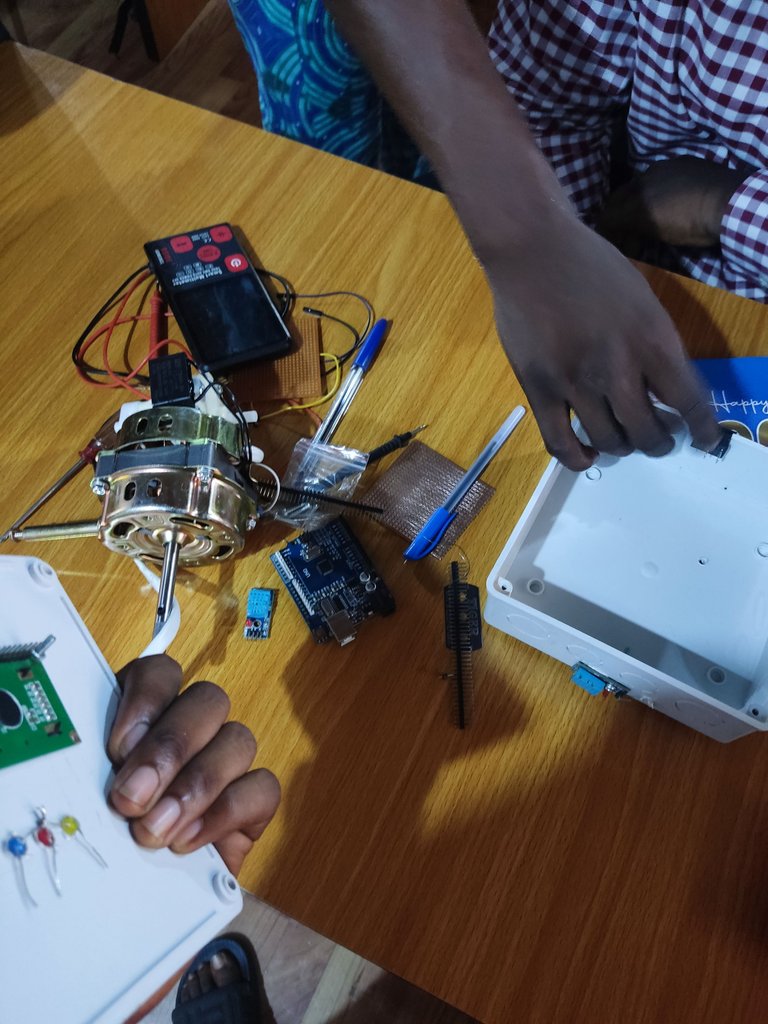
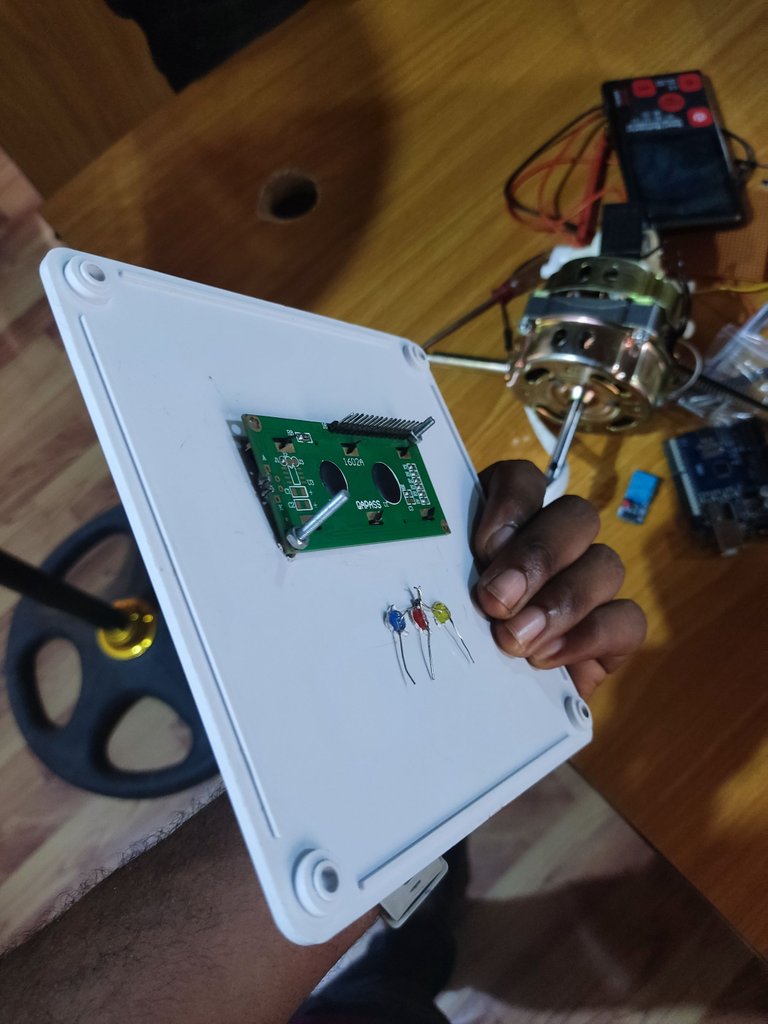
How do we plan on building this project, first we have a box where we placed in our LCD which would display the room temperature and the changes in speed of the fan. For the fan, there are four wires, in which we have the wire 1, wire 2, wire 3, and the neutral (wire4). Each of those wires signifies the speed of the fan.
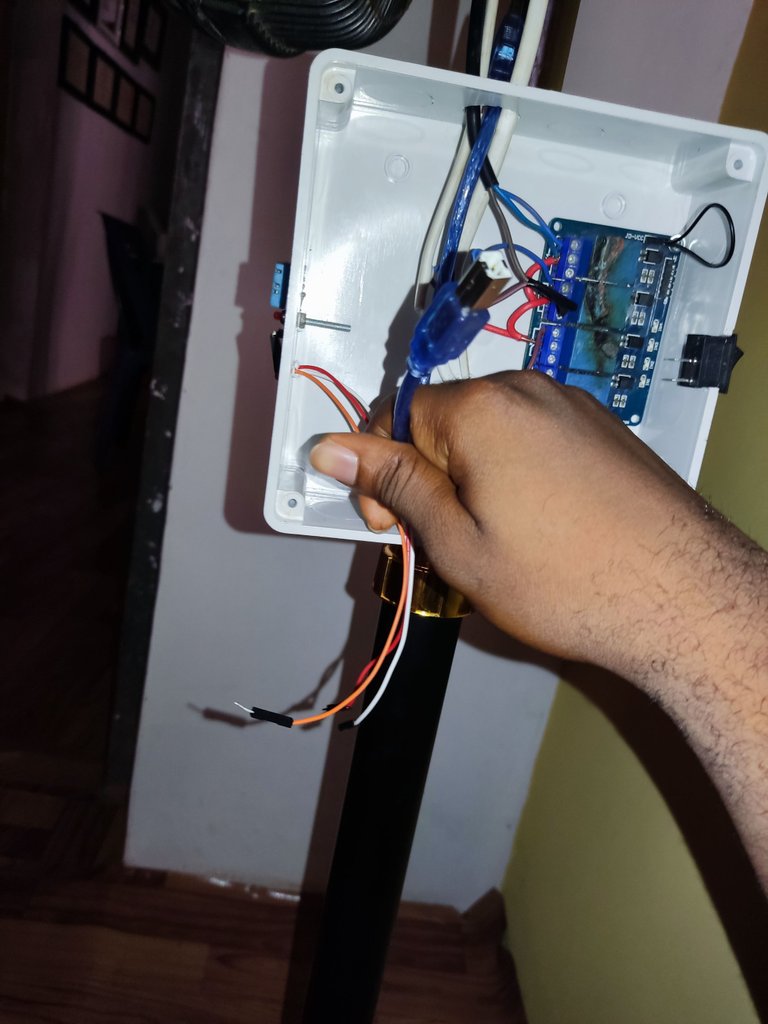
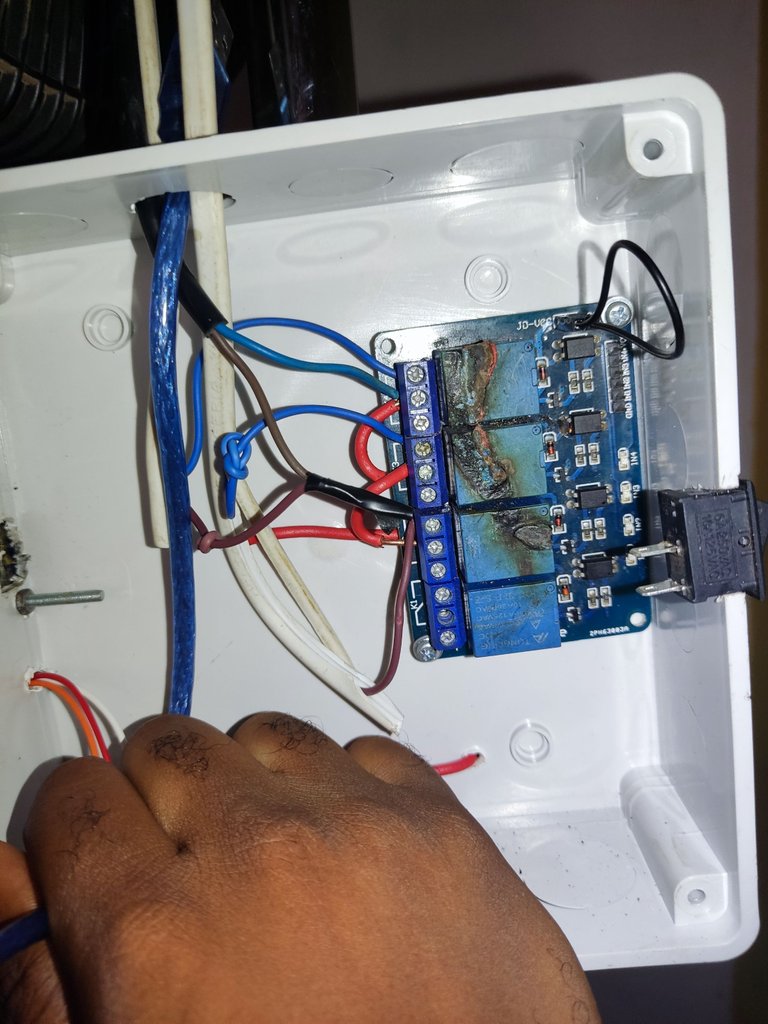
Above is the relay module in which we connect to the fan. We loop in the Normally close to each relay and connect each speed to the normally open of the relay module.

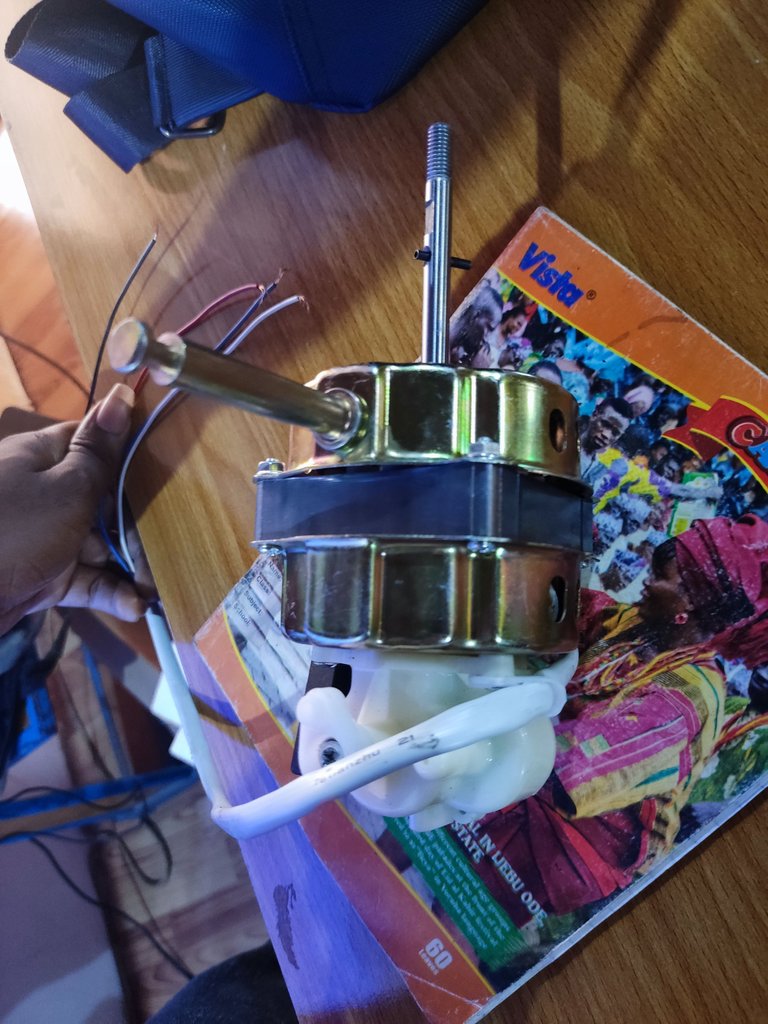
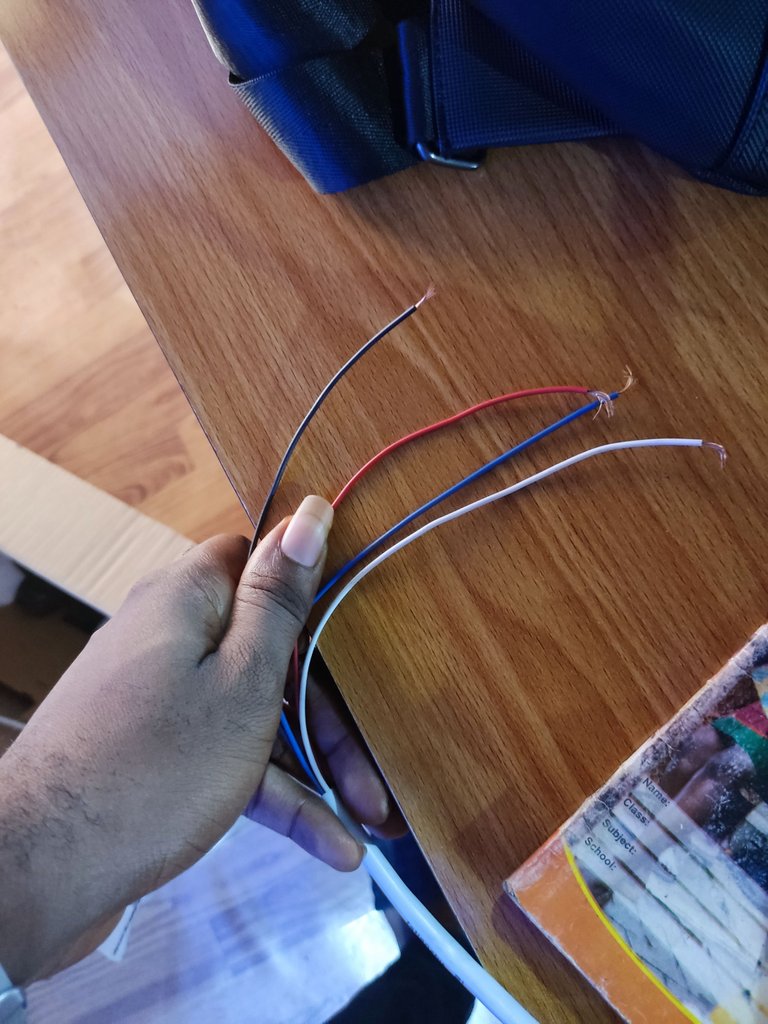
Above is the fan motor used to test our code if it would work. We have the 3speeds and ground wire in it.
Below is the connection of the fan motor to the relay and arduino..
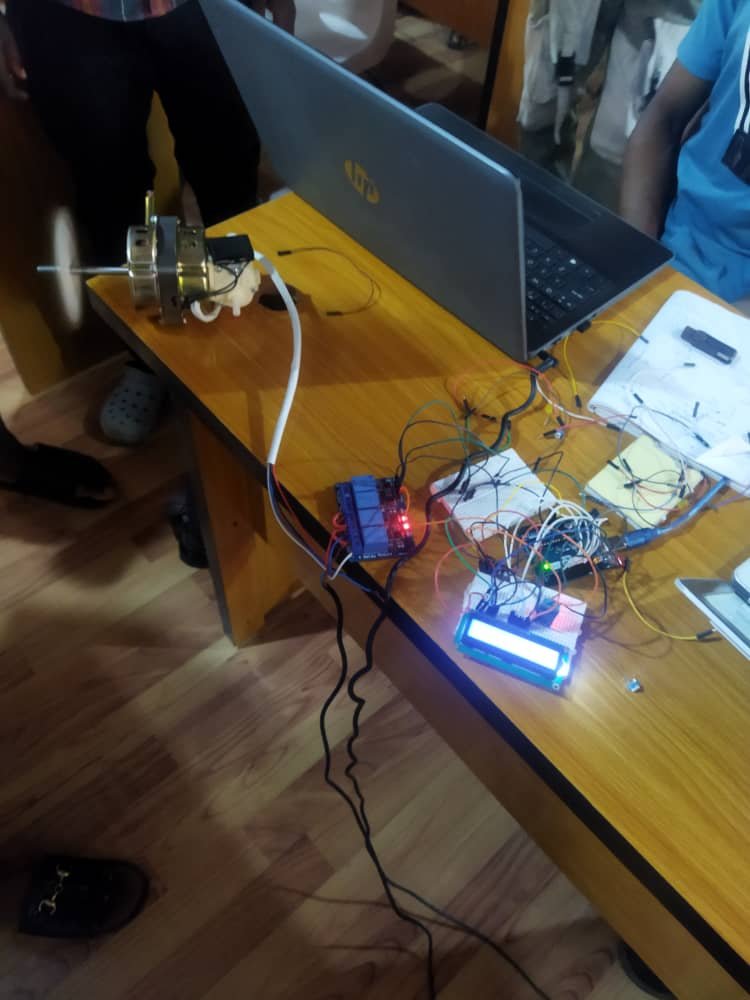
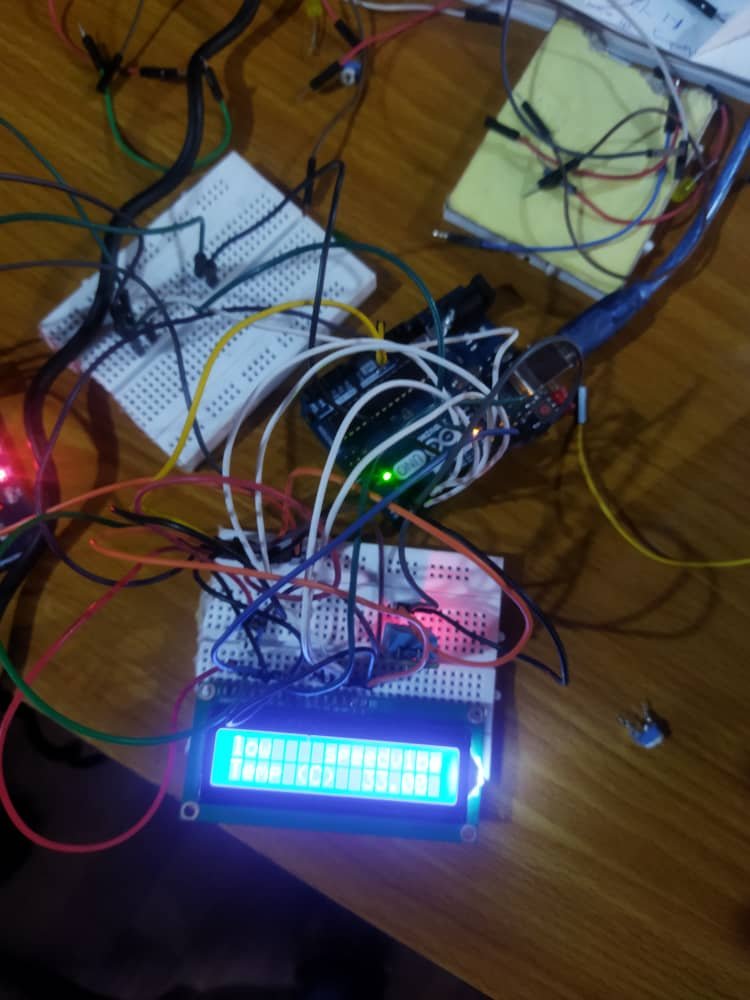
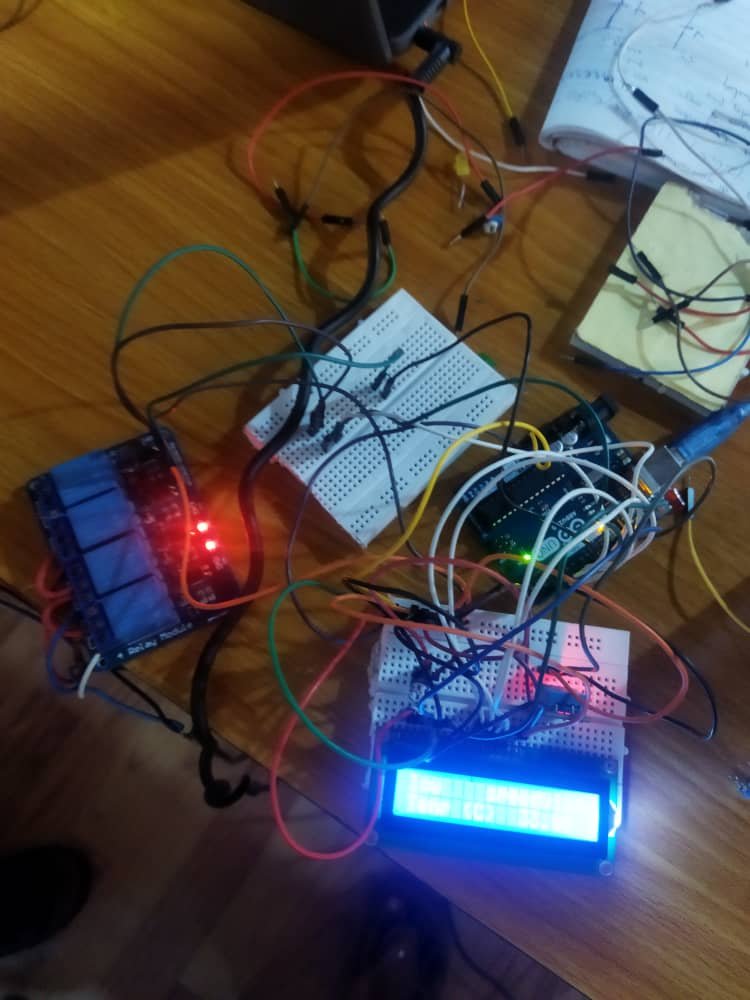
In the pictures below is the code for this project on my system.
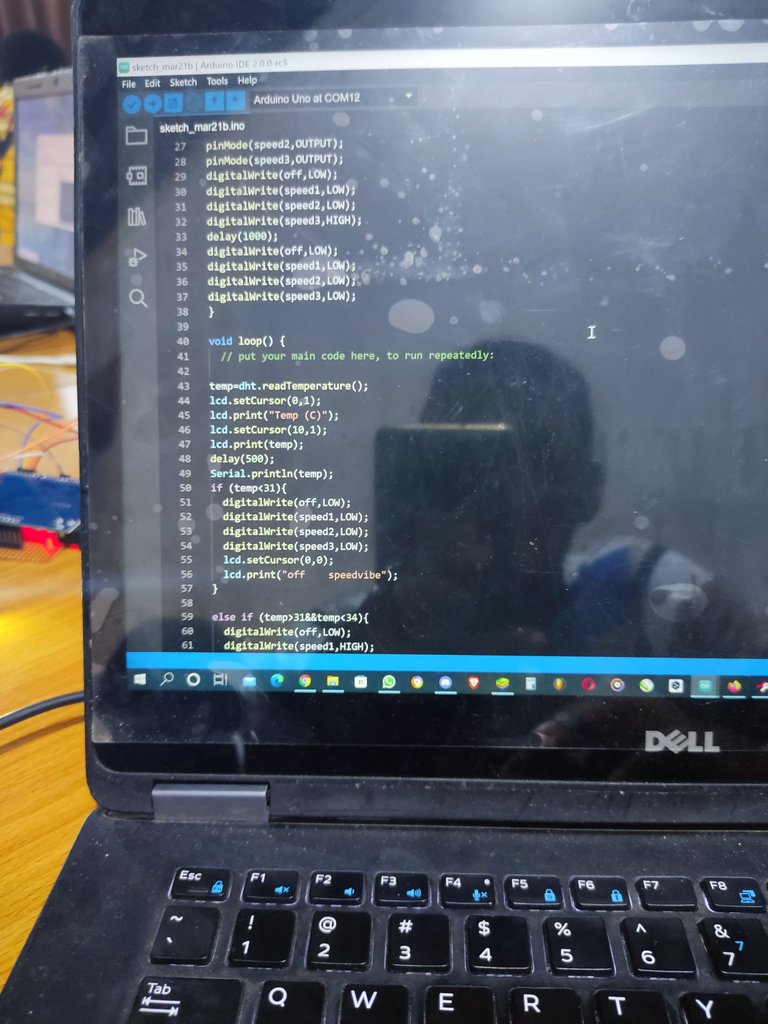
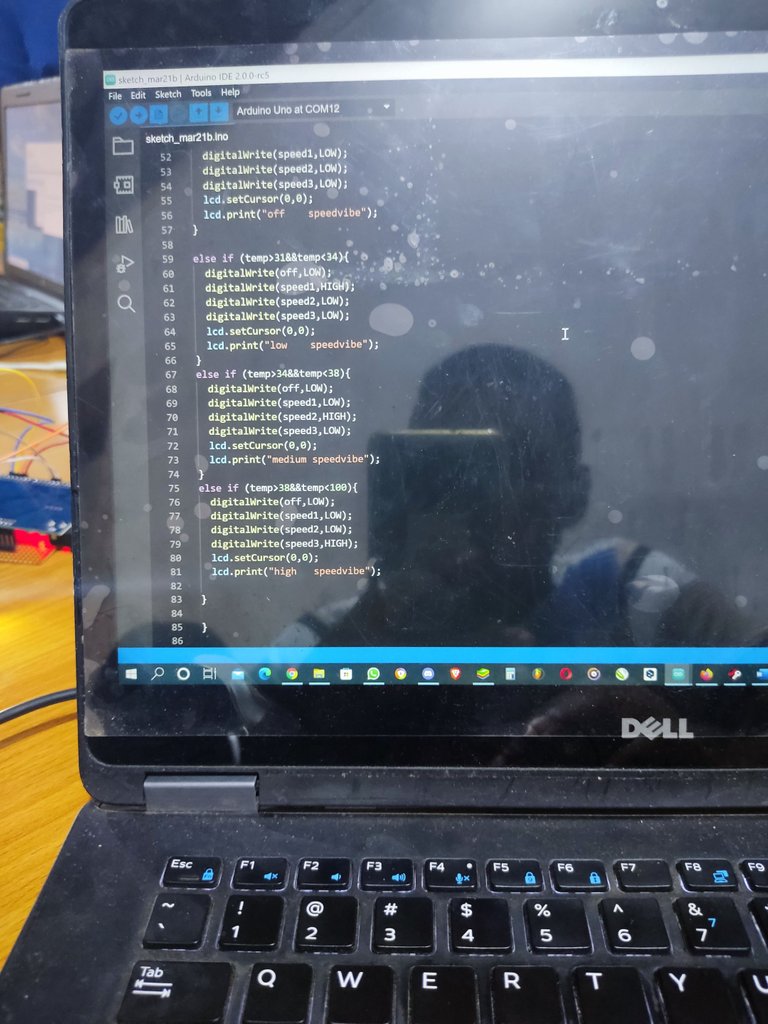
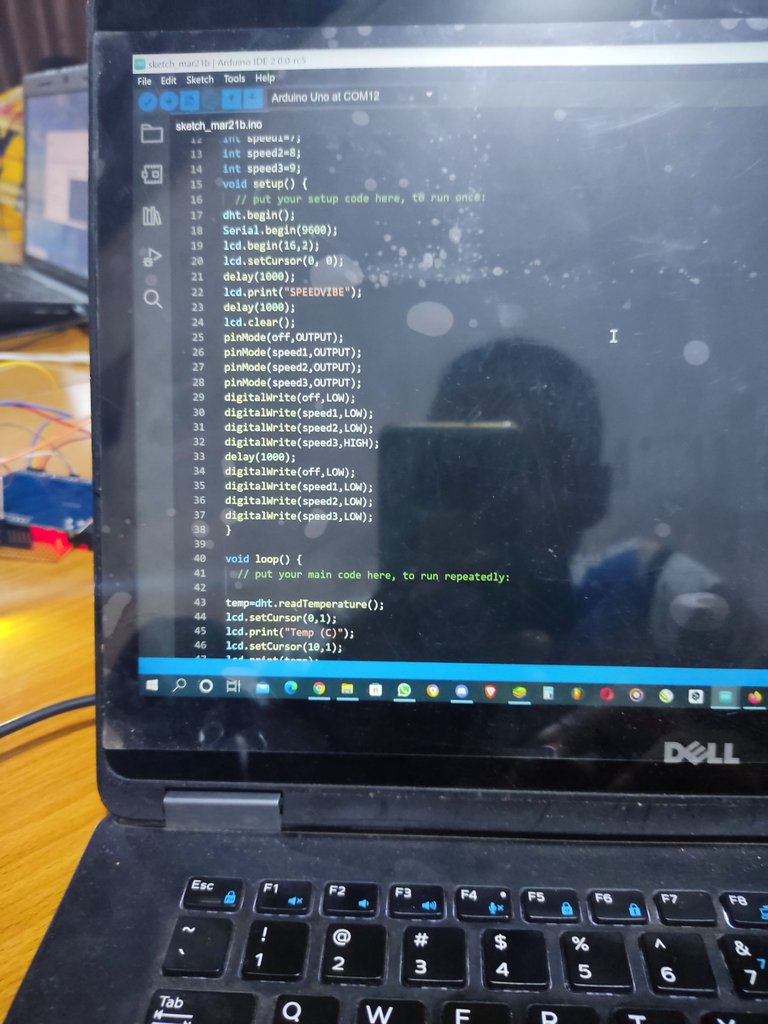
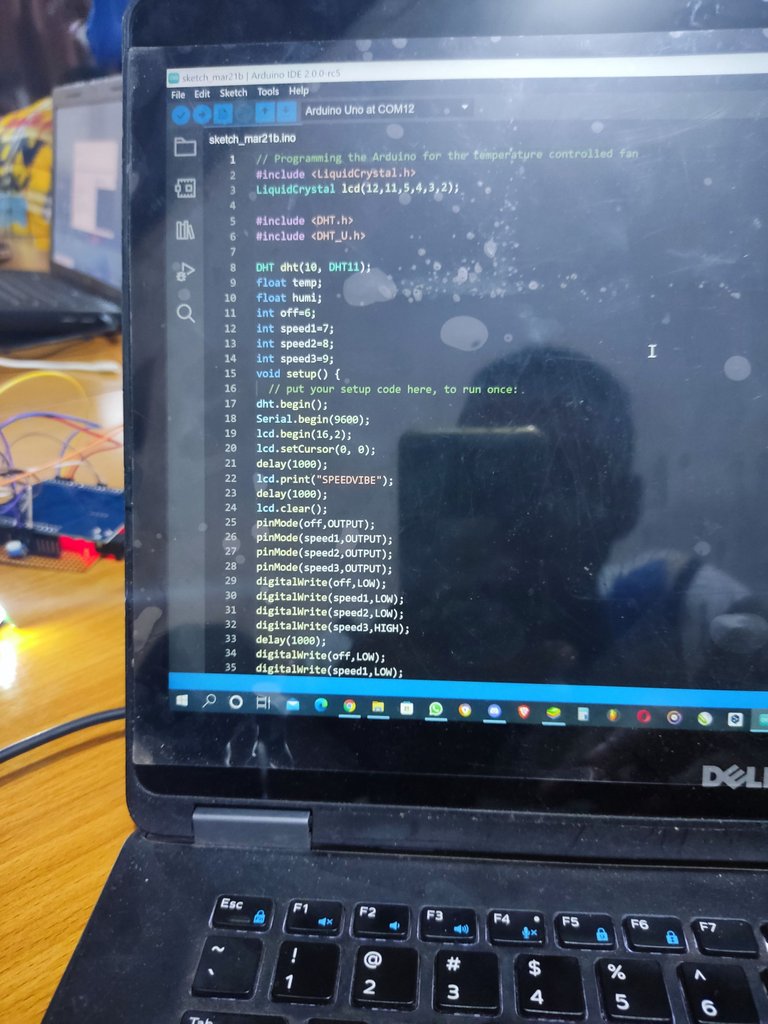
Below is the code written in my system for the dht11, led light and relay module
// Programming the Arduino for the temperature controlled fan
#include <LiquidCrystal.h>
LiquidCrystal lcd(12,11,5,4,3,2);
#include <DHT.h>
#include <DHT_U.h>
DHT dht(10, DHT11);
float temp;
float humi;
int off=6;
int speed1=7;
int speed2=8;
int speed3=9;
void setup() {
// put your setup code here, to run once:
dht.begin();
Serial.begin(9600);
lcd.begin(16,2);
lcd.setCursor(0, 0);
delay(1000);
lcd.print("SPEEDVIBE");
delay(1000);
lcd.clear();
pinMode(off,OUTPUT);
pinMode(speed1,OUTPUT);
pinMode(speed2,OUTPUT);
pinMode(speed3,OUTPUT);
digitalWrite(off,LOW);
digitalWrite(speed1,LOW);
digitalWrite(speed2,LOW);
digitalWrite(speed3,HIGH);
delay(1000);
digitalWrite(off,LOW);
digitalWrite(speed1,LOW);
digitalWrite(speed2,LOW);
digitalWrite(speed3,LOW);
}
void loop() {
// put your main code here, to run repeatedly:
temp=dht.readTemperature();
lcd.setCursor(0,1);
lcd.print("Temp (C)");
lcd.setCursor(10,1);
lcd.print(temp);
delay(500);
Serial.println(temp);
if (temp<31){
digitalWrite(off,LOW);
digitalWrite(speed1,LOW);
digitalWrite(speed2,LOW);
digitalWrite(speed3,LOW);
lcd.setCursor(0,0);
lcd.print("off speedvibe");
}
else if (temp>31&&temp<34){
digitalWrite(off,LOW);
digitalWrite(speed1,HIGH);
digitalWrite(speed2,LOW);
digitalWrite(speed3,LOW);
lcd.setCursor(0,0);
lcd.print("low speedvibe");
}
else if (temp>34&&temp<38){
digitalWrite(off,LOW);
digitalWrite(speed1,LOW);
digitalWrite(speed2,HIGH);
digitalWrite(speed3,LOW);
lcd.setCursor(0,0);
lcd.print("medium speedvibe");
}
else if (temp>38&&temp<100){
digitalWrite(off,LOW);
digitalWrite(speed1,LOW);
digitalWrite(speed2,LOW);
digitalWrite(speed3,HIGH);
lcd.setCursor(0,0);
lcd.print("high speedvibe");
}
}
https://twitter.com/Starstrings1/status/1505903298875908103
The rewards earned on this comment will go directly to the person sharing the post on Twitter as long as they are registered with @poshtoken. Sign up at https://hiveposh.com.
Great job dear professor ❣️
I am also learned from your post.
I am also a mechanical engineer but due to some problems currently not doing job.
In my side this is awesome post for learning about Fan controling system through the temperature 🌡️
Yeah.. it actually took me time to compile and gain inspiration to write the post. Can you believe I had started writing this post since last week Wednesday?.. it was today I had to force myself to compute down something.
I know you have also a big Dream professor ❣️
Please, please, please motivate yourself with confidence.
Spend some time with dear person.
I think you can changed your mind set-up ❣️
Believe in yourself professor ❣️
You can do it 🥀
Incredible! You're already doing things. I've always wanted to ask, how difficult is doing this or rather learning this?
It is actually not difficult but only needs rehearsing it over and over again after being taught if not, it is easy to forget.
Interesting read.
I should get my hands on some of these coding skills soon.
They look quite invaluable for things like this.
Great job boss, the need for automation and automated regulation of electronic appliances such as fans, lighting, etc is highly required. I so much love and enjoy automating things, building solutions, and making how appliances are been monitored or controlled smarter and better. And I so much appreciate you doing that too.
Keep up the great work champ 👍.
I know you do brother, that's why I have a lot to learn from you.
I could see you used a 4-channel relay module for switching between different voltage levels. Because the applied voltage is directly proportional to the amount of torque generated by the fan and as the voltage varies so does the speed varies based on the temperature range programmed in the microcontroller.
Yeah but I didn't make use of the last channel though... I don't know how much you are busy but I would love if we could meet bro.
Hmm, see the programming I have often dislike been employed for good use...
Actually this kind of a fan is needed for this season, a solution to everyday problem like is such a blessing.
Nice one, keep it up.
Yeah it is oh especially in Nigeria where everywhere can be hot. Just have the fan be sensing the temperature of the room and be changing its speed according to it.
It is a great course and l wish you the best in this bro.
Thanks a lot brother, I really appreciate
You made a great project and shared it with others, I salute your kind soul who always wants to share with others whatever you are doing
Thank you very much... I really appreciate your kind words.
Congratulations @starstrings01! You have completed the following achievement on the Hive blockchain and have been rewarded with new badge(s):
Your next target is to reach 10500 replies.
You can view your badges on your board and compare yourself to others in the Ranking
If you no longer want to receive notifications, reply to this comment with the word
STOPCheck out the last post from @hivebuzz:
Woah super dope!
I can imagine the wonderful time you had doing this.
My immediate sibling is an arduino programmer too. Test running a successful code is usually a fun-time in my family.
Well done!
Is he a funaabite too? Would love to meet him
He was, he is presently serving. I could still connect you guys if you wish to.
Nice job. Really inspiring.
This project is massive.
Weldon to you and your team💪
Yeah thank you very much... I appreciate
If you package those into no soldering kits, they might sell.
You mean something like a DIY kit? Then an instruction on how to build it?
Yep.
They should be plug and play, if you can.
I would target electrical stores, too.
If you get a distributor to a couple cities, you would be set.
Lots of people will want to save the electricity that comes with less fan use.
Saving electricity... Hmm means the fan would have a battery to use it when there isn't eletricity and a charger to charge when low.
Different models can have different features.
Depending on the price they are willing to pay.
Mechatronist in the making. This is awesome. Can't wait for the moment you'll start working on airplanes and the likes. Well done bro @starstrings01
Wow it's dope and I wanted to have this one. I will try to study this and make one of my own someday! Thanks for sharing this very great innovation!
!1UP
Yeah I understand, thanks very much.
You have received a 1UP from @ivarbjorn!
@stem-curator, @vyb-curator, @pob-curator, @pal-curatorAnd they will bring !PIZZA 🍕
Learn more about our delegation service to earn daily rewards. Join the family on Discord.